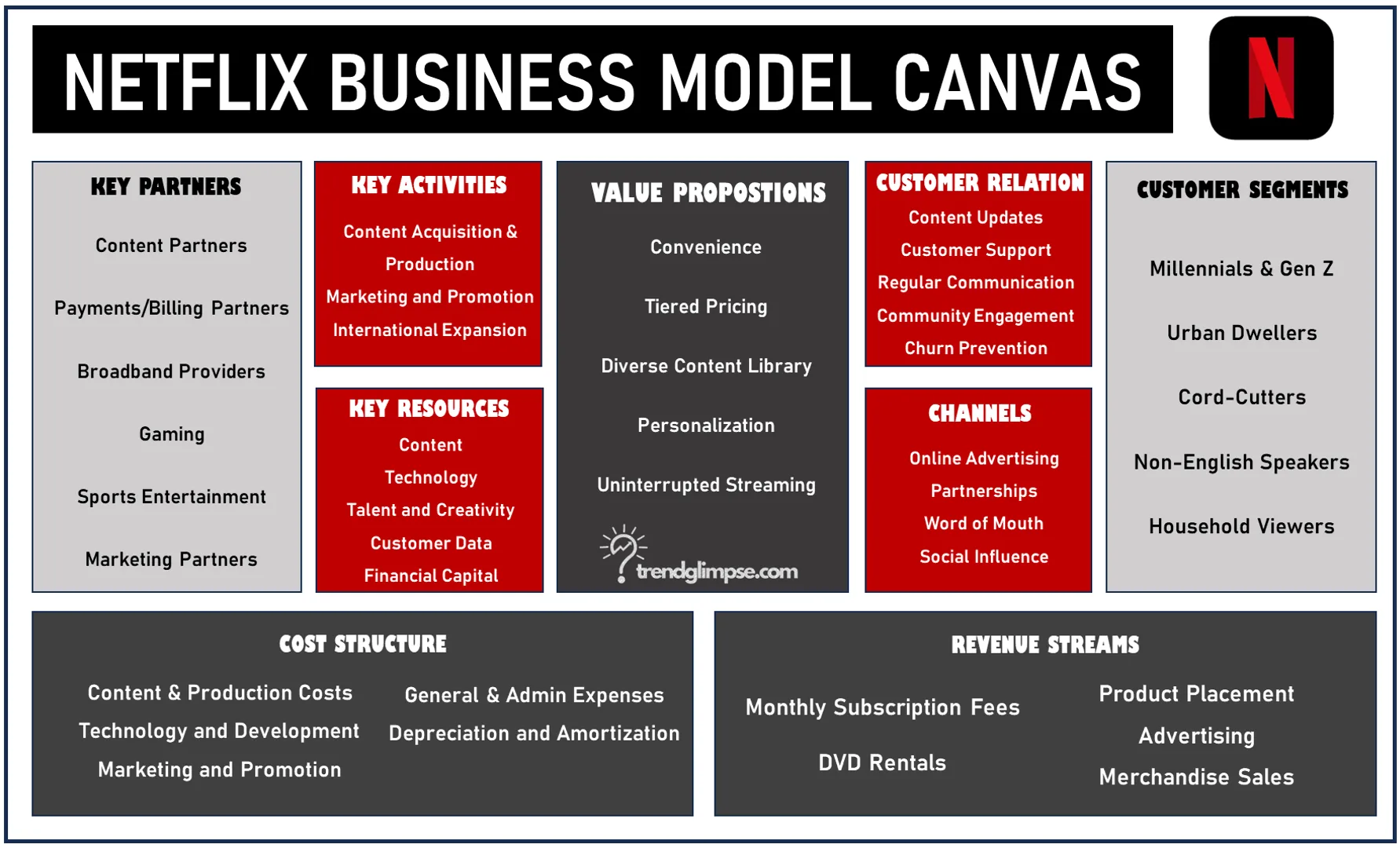What is Netflix?
As you know, Netflix has become the dominant force in the streaming entertainment space over the last decade. But how exactly did a company once known primarily for mailing DVDs achieve this remarkable transformation?
Headquarters: Los Gatos, California, United States
Industry: OTT Streaming
Founded By: Reed Hastings & Marc Randolph
Subscriber Count [2023]: ~222 Million
Revenue [2023]: $ 33.72 Billion
Website: netflix.com
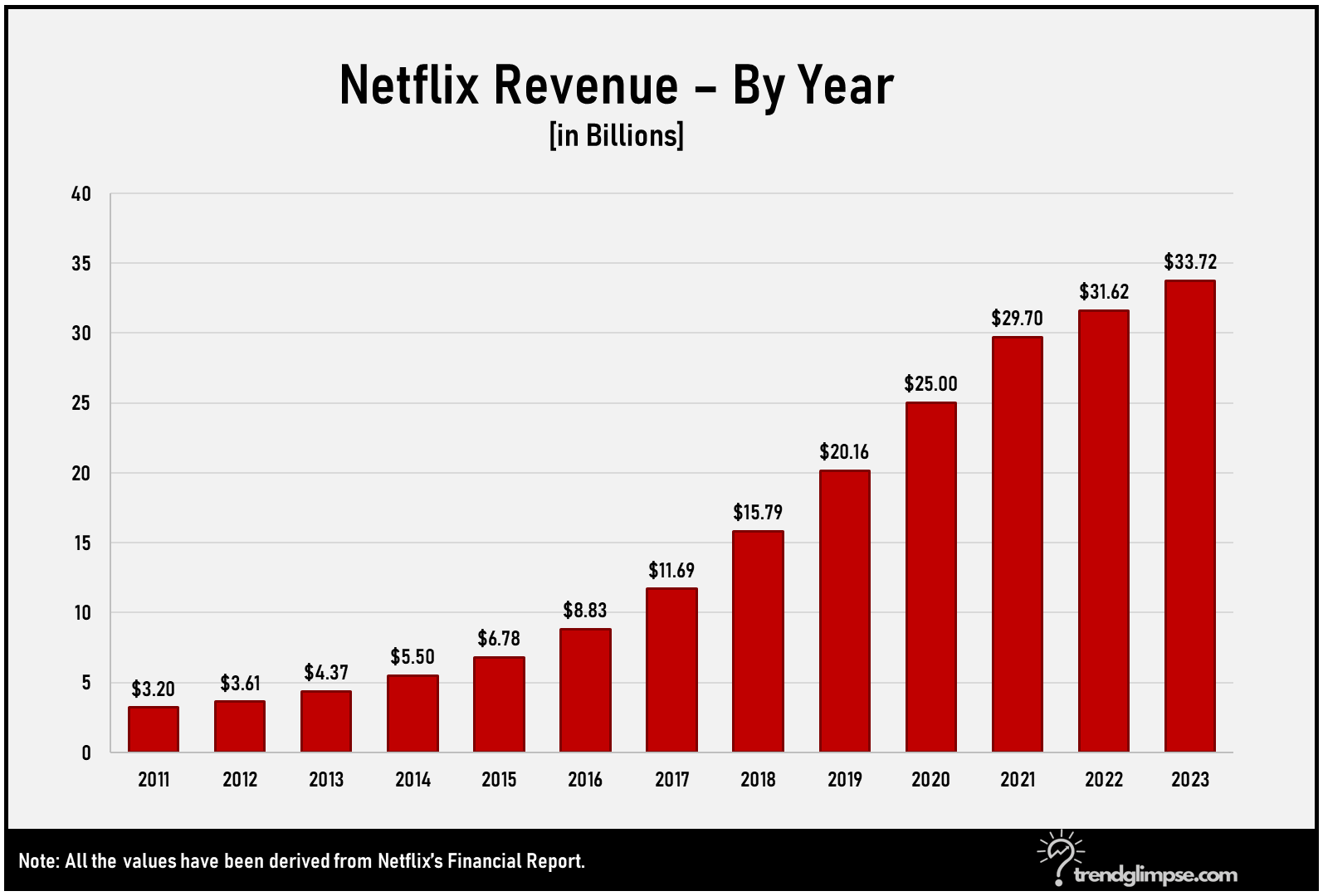
With over 222 million subscribers globally, Netflix is the world’s leading subscription-based streaming service, offering TV series, films, and original content. Netflix’s subscription revenues have grown rapidly, reaching over $33.72 billion in 2023. However, the company operates on thin profit margins as it continues to invest heavily in content. Netflix posted net income of $5.4 billion in 2023.
North America: 44.09%
EMEA: 31.29%
Asia-Pacific: 13.16%
Latin America: 11.17%
Competitors of Netflix
Hulu, HBO Max, Discovery+, Amazon Prime Video, Apple TV+, Disney Plus, Paramount+, Peacock
Let’s take a look at how the Netflix business model has evolved over time into an industry-leading streaming platform. A close analysis of the Netflix business model reveals how its subscriber-based revenues, evolving content library, proprietary technology, and other factors have come together to make Netflix a dominant force.
Revenue Streams
Monthly Subscription Fees
Netflix’s core revenue stream comes from monthly subscription fees paid by its members. As of 2022, Netflix had around 222,924 million paying subscribers globally. The standard Netflix monthly subscription in the U.S. is $15.86, so with that many subscribers, subscription fees add up quickly!
Netflix has been steadily raising prices over the years as it spends more on content. While some price hikes have led to subscriber losses, Netflix remains committed to providing a wide breadth of content to justify the cost. The company brought in over US$ 31.47 billion in total revenue from subscriptions in 2022 alone. As long as Netflix can continue to attract new subscribers, subscription fees will likely remain its primary revenue driver.
DVD Rentals
While DVD rentals were once Netflix’s core business when it started in 1997, this legacy revenue stream is now coming to an end. In 2022, Netflix still generated $145 million in DVD rental revenue from its remaining 1.5 million DVD subscribers. However, on September 29, 2023, Netflix announced it is officially shutting down its DVD-by-mail service after over 25 years.
The key reason Netflix cited for closing down DVD rentals is the continued shift of consumer preference toward streaming. With streaming now dominating the market, maintaining the infrastructure and overhead for a declining DVD rental business no longer makes financial sense. The resources required to manage DVD logistics and inventory can be fully redirected to expanding Netflix’s streaming content and features.
Product Placement And Advertising
Unlike most streaming platforms, Netflix does not run traditional ads on its service. However, it does incorporate paid product placement into some of its original programming. Companies can pay to have their products featured or mentioned in Netflix shows in a natural, organic way.
While not a primary revenue focus, product placement provides some additional revenue from Netflix’s original content investments. In April 2022, Netflix has also indicated it may introduce an ad-supported subscription tier to supplement revenue. The ad-supported tier now accounts for 40% of all Netflix sign-ups in its ad markets. Co-CEO Greg Peters mentioned that the ad-supported offering has 23 million monthly active users and that Netflix’s priority is further scaling this base.
Merchandise Sales
Capitalizing on its popular IP, Netflix launched an online store called Netflix.shop in 2021, featuring exclusive, high-quality collectibles and merchandise from its shows. While still a small portion of revenue, Netflix is smartly leveraging the passionate fandom around its shows. For instance, Netflix.shop sells apparel, toys, games, and other products related to Stranger Things, Squid Game, and other hits.
Netflix is also partnering with brands like Athletic Brewing and Lacoste on limited-edition product collaborations. This merchandising foray is partly to capitalize on opportunities missed in the past, where unofficial sellers profited from demand for products tied to Netflix’s shows. Beyond merchandise, Netflix is also generating revenue from live experiential events like the “Bridgerton Ball” and an immersive “Squid Game” experience.
Customer Segments
Millennials and Generation Z
Millennials and Generation Z make up a significant portion of Netflix’s customer base. According to a Morning Consult report, Netflix is the most popular streaming platform for Gen Z, with 75% of Gen Z in the US watching it every month. This highlights Netflix’s appeal among younger generations who have grown up in the internet era and expect on-demand entertainment.
And Netflix is smart; they know just how to appeal to the younger crowd. Series like Stranger Things capture youth culture and resonate strongly with younger viewers. Looking ahead, Netflix will need to continue evolving its content and products. Because the moment they lose interest, millennials and Gen Zers will abandon Netflix quicker than you can say “binge-watch.”
Urban Dwellers
It’s no shocker that Netflix is hugely popular within the city, folks. According to a recent survey by Morning Consult, almost half of Netflix’s American subscribers are located in urban areas (43%), while about one-third live in suburban areas (33%).
It makes sense when you think about it. These digital-savvy city dwellers tend to hop on new tech trends early. And with so many people packed into cities, who has time to make it to the cinema anymore? Netflix provides that instant, on-the-go entertainment fix. Netflix’s mobile apps and download features are well suited to urban users who may be commuting on subways or traveling frequently.
Cord-Cutters and Cord-Nevers
Everyone’s talking about ditching cable these days. It has been reported that the major cable providers collectively lost over 6 million pay-TV subscribers each year between 2019 and 2022. And in 2023 alone, nearly 5 million people decided to cut the cord, bringing the total to 39.3 million cord-cutters. That’s almost a 19% jump from the previous year.
For these cable-fatigued consumers, Netflix is a breath of fresh air with its flexible, no-contract setup and ever-changing content library. By catering to cord-cutters, Netflix has seriously capitalized on this entertainment revolution.
Family and Household Viewers
And we can’t forget the families! Multi-user accounts allow various family members to access Netflix’s family-friendly content library. Animated films and shows keep kids engaged, while adults enjoy Netflix’s original series and licensed shows. With mature filters and personalized profiles, parents can manage their viewing worry-free. Besides, Netflix has also cultivated partnerships with trusted brands like Mattel for interactive kids content.
International/Non-English Speakers
International and non-English-speaking subscribers represent a massive growth opportunity for Netflix. Squid Game and Money Heist are two of the most popular non-English language shows on Netflix, with Squid Game having 265.2 million views and Money Heist over 106 million.
With almost 70% of subscribers already outside the US, emerging regions like Asia-Pacific are primed for massive growth as the middle class expands. By producing content in local languages and licensing international media, Netflix gains a competitive edge against domestic streaming rivals abroad.
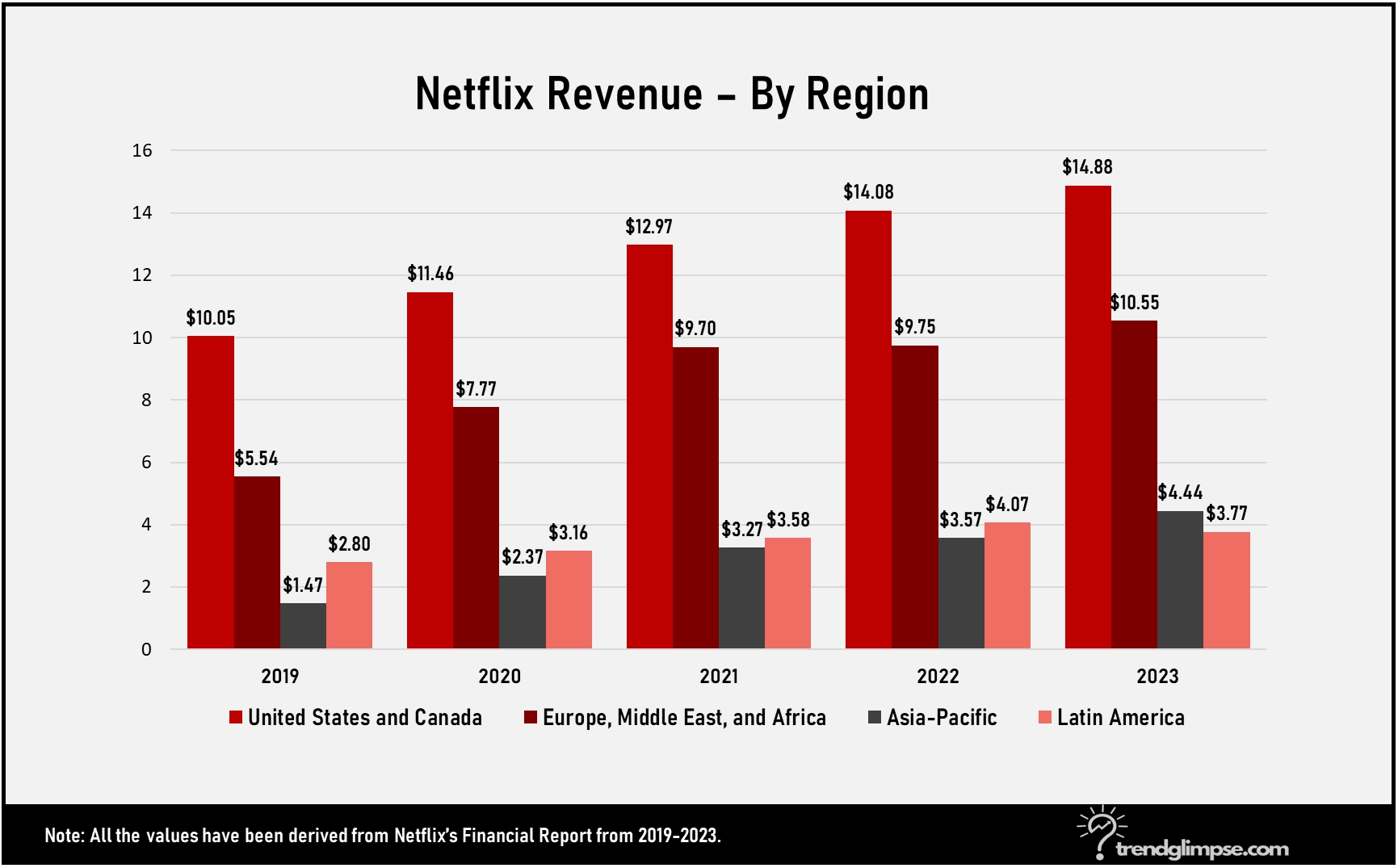
Key Partners
Content Partners
Netflix partners with various production houses, movie studios, TV networks, etc. to license streaming rights for their content. Some partners include Sony, Warner Bros., NBCUniversal, The CW, BBC, Lionsgate, ABC Studios, Discovery, etc. Netflix had signed a significant pay-one licensing deal with Sony Pictures Entertainment for the exclusive U.S. rights to stream Sony’s theatrical releases in the first pay TV window, starting with the studio’s 2022 film slate.
Payments/Billing Partners
For processing subscriptions and payments in different countries, Netflix works with payment partners like Braintree, Recurly, Stripe, PayPal, Visa, Mastercard, etc. In India, Netflix was the first merchant to launch UPI autopay, while in Indonesia, leading mobile wallet GoPay was the first e-money payment option on Netflix in the country.
Broadband Providers
Partnerships to offer bundled broadband and Netflix plans exist with companies like BT, Virgin Media, Sky Broadband, etc. In September 2023, Netflix established a strategic partnership with SK Telecom and SK Broadband in South Korea to enhance customers’ entertainment experiences. Moreover, in March 2018, Sky and Netflix announced a partnership to bundle the full Netflix service into a brand new Sky TV subscription pack.
Gaming and Sports Entertainment
Netflix is making major partnerships to boost its mobile gaming offerings and live sports content. In 2023, Netflix launched three exclusive mobile games in partnership with Ubisoft. The games were based on the popular franchises Valiant Hearts, Mighty Quest, and Assassin’s Creed.
Netflix also secured a landmark 10-year licensing deal with WWE in January 2024 worth over $5 billion. This gives Netflix exclusive streaming rights to WWE’s flagship programming, Monday Night Raw. These deals demonstrate Netflix’s commitment to delivering premium entertainment experiences to attract and retain subscribers.
Marketing Partners
In 2022, Domino’s created its largest entertainment integration ever with a “Stranger Things” mind-ordering app. This allowed fans to place pizza orders using pretend telekinesis powers. Pepsi also celebrated the finale of “Money Heist” in September 2021 with limited edition golden cans featuring the show’s iconic Dali mask and “Bella Ciao” song. These cans were part of a virtual fan party Pepsi hosted leading up to the premiere.
Cost Structure
Content & Production Costs
Netflix spends heavily on content production and licensing, with plans to have content expenses of $17 billion in 2024. This includes original content produced by Netflix as well as licensed shows and movies. Netflix aims to offer a large content library with broad appeal globally. But as competition increases, Netflix will likely have to spend even more on high-quality original content to attract and retain subscribers.
Technology and Development
Netflix invests heavily in its streaming technology and development, with tech and development costs of $2.7 billion in 2022. This includes improving its recommendation algorithms, streaming quality, user interface, and expanding capabilities like mobile downloads. As a streaming pioneer, Netflix prioritizes tech innovation to enhance the user experience and support global growth.
Marketing and Promotion
In 2022, Netflix spent $2.5 billion on marketing, promoting its brand and shows. Netflix utilizes broad marketing like TV ads and billboards, as well as data-driven targeted ads. As competition increases, Netflix will likely boost marketing to retain current users and attract new ones. Word-of-mouth promotion is also key; Netflix leverages its brand power and quality originals to gain free buzz. Viral hits like Bird Box demonstrate Netflix’s marketing strengths.
General and Administrative Expenses
In 2022, general and administrative expenses totaled $1.5 billion for Netflix. This covers corporate functions like finance, legal, human resources, etc. As Netflix expands globally, general expenses will likely rise to support growth. But Netflix aims to maintain a lean corporate structure; its core focus is on streaming content and the tech to support it. So Netflix strives to keep general/admin costs down through organizational efficiency.
Depreciation and Amortization
Depreciation and amortization costs relate chiefly to the depreciation of the IT infrastructure and technology needed to support its streaming platform. As Netflix continues to expand globally and invest in technology, its depreciation costs will also rise. But depreciation is a non-cash expense that does not impact cash flow, only accounting for net income. Netflix views depreciation as a necessary cost to scale up the technology and systems needed to achieve its growth goals.
Value Proposition
Convenience
Seriously, how convenient is Netflix? With just a click or two, you’ve got a huge library of entertainment ready to stream. There is no need to go to the video store or wait for DVDs in the mail. Netflix lets you watch on your phone, tablet, laptop, or TV—whenever and wherever you want.
Moreover, their intuitive interface makes browsing and discovering new content a breeze. Features like personalized picks and offline downloading make binge-watching even easier. And one monthly subscription fee unlocks unlimited access—no complicated contracts or hidden costs. Netflix strives to take all the hassle out of home entertainment.
Tiered Pricing
One aspect that sets Netflix apart is its tiered pricing structure. They offer plans to suit every budget. The Basic plan, at US$ 15.49 per month, gives you access to standard definition streaming on one device. Step up to the
Standard plan at US$ 22.99 per month, and you can stream in HD on two devices simultaneously. They also let you add an extra member for US$ 7.99 per month. Having these tailored pricing options lets subscribers choose the plan that provides the right balance of features and cost for their needs. It’s a smart model that opens up Netflix to a broader audience.
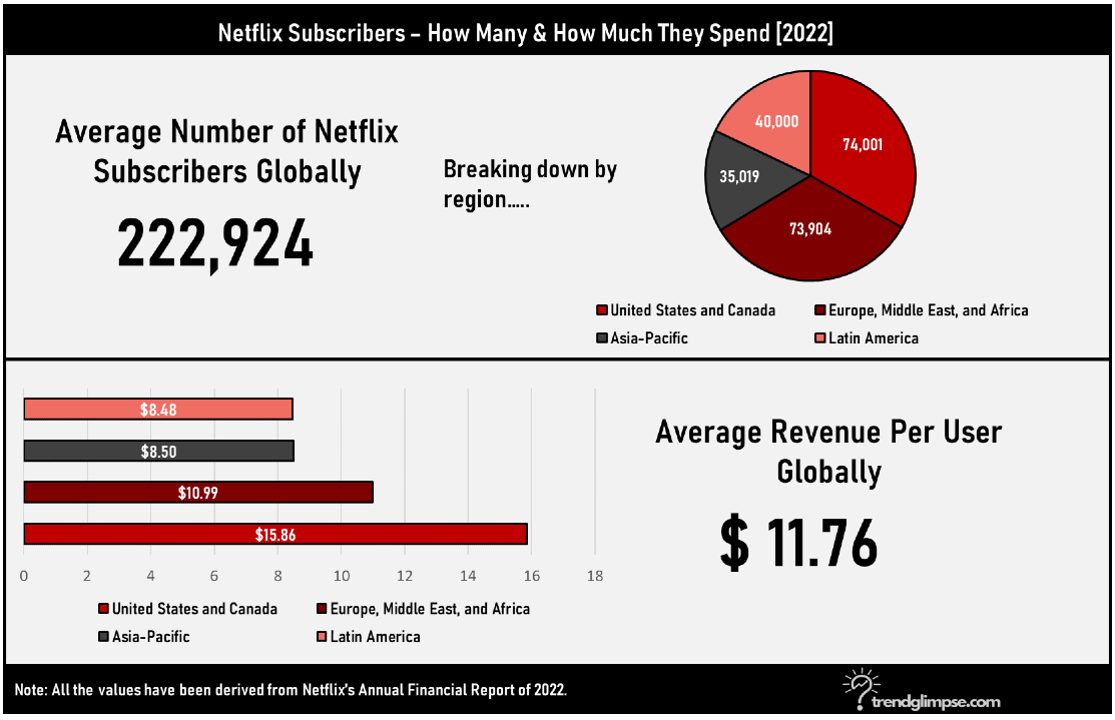
Diverse Content Library
With over 200 million global subscribers, Netflix clearly offers something for every taste. Their content library is mega diverse, from retro classics and indie darlings to new releases, foreign flicks, and bingeable Netflix originals.
Plus, Netflix invests heavily in local content for worldwide markets. No matter your mood or interests, Netflix has you covered. Subscribers love being constantly surprised by hidden gem movies and shows. With thousands of new additions monthly, the Netflix catalog feels endless and ever-evolving.
Personalization
A key part of the Netflix value proposition is their industry-leading personalization technology. Based on your viewing history and interactions, Netflix builds unique taste profiles. This powers a tailored experience with recommendations handpicked just for you. The home page showcases titles Netflix thinks you’ll enjoy. Search results spotlight your favorite genres and actors first. Even the artwork is customized to draw you in. Features like “Top Picks for [Your Name]” make finding your next binge too easy.
Uninterrupted Streaming
Netflix makes sure nothing interrupts your streaming. Their global content delivery network ensures a reliable, high-quality picture. Buffering and lag are essentially eliminated.
Download episodes to keep watching offline when traveling or without WiFi. Parental controls let you create PIN-locked profiles to manage kids’ access. Personal profiles keep everyone’s watch history and picks separate. Netflix’s technology enhances streaming rather than interrupting the experience.
Channels
Online/Mobile Advertising
Netflix relies heavily on online and mobile advertising to promote its content and platform. They use advanced targeting to serve relevant ads to viewers based on their interests and viewing habits. For example, if you watch a lot of sci-fi shows, you may see Netflix ads for Stranger Things or Altered Carbon.
Partnerships with Device Manufacturers
Netflix partners with smart TV, mobile, and gaming device manufacturers to integrate the Netflix app into their products. For example, Netflix comes pre-installed on many LG, Samsung, and Sony smart TVs. These partnerships make Netflix highly visible and accessible to new audiences. Device partnerships also keep Netflix top of mind as users interact with their TVs, phones, and game consoles on a daily basis.
Distribution Partnerships
Netflix partners with cable and satellite providers and telcos to bundle Netflix with TV and internet service packages. Major partners include Comcast, DISH Network, Verizon, and Sky. These distribution partnerships help Netflix tap into existing customer bases. Distribution partners benefit by upselling and retaining subscribers, while Netflix gains new members.
Word of Mouth and Social Influence
When it comes to marketing, Netflix leans into good old-fashioned word of mouth and social buzz. Netflix’s original shows have become cultural phenomena, sparking conversation and recommendations.
Netflix also encourages sharing on social media through official accounts and hashtags like #NetflixAndChill. Reviews and reactions on YouTube, TikTok, Instagram, and Twitter often go viral, attracting curious viewers to sign up and participate.
Email Marketing
Netflix uses email campaigns to engage current subscribers and attract new ones. They send subscribers timely promos on new releases, reminders to keep binge-watching favorite shows, and suggestions based on viewing history. Non-subscribers get email ads spotlighting originals and free trial deals.
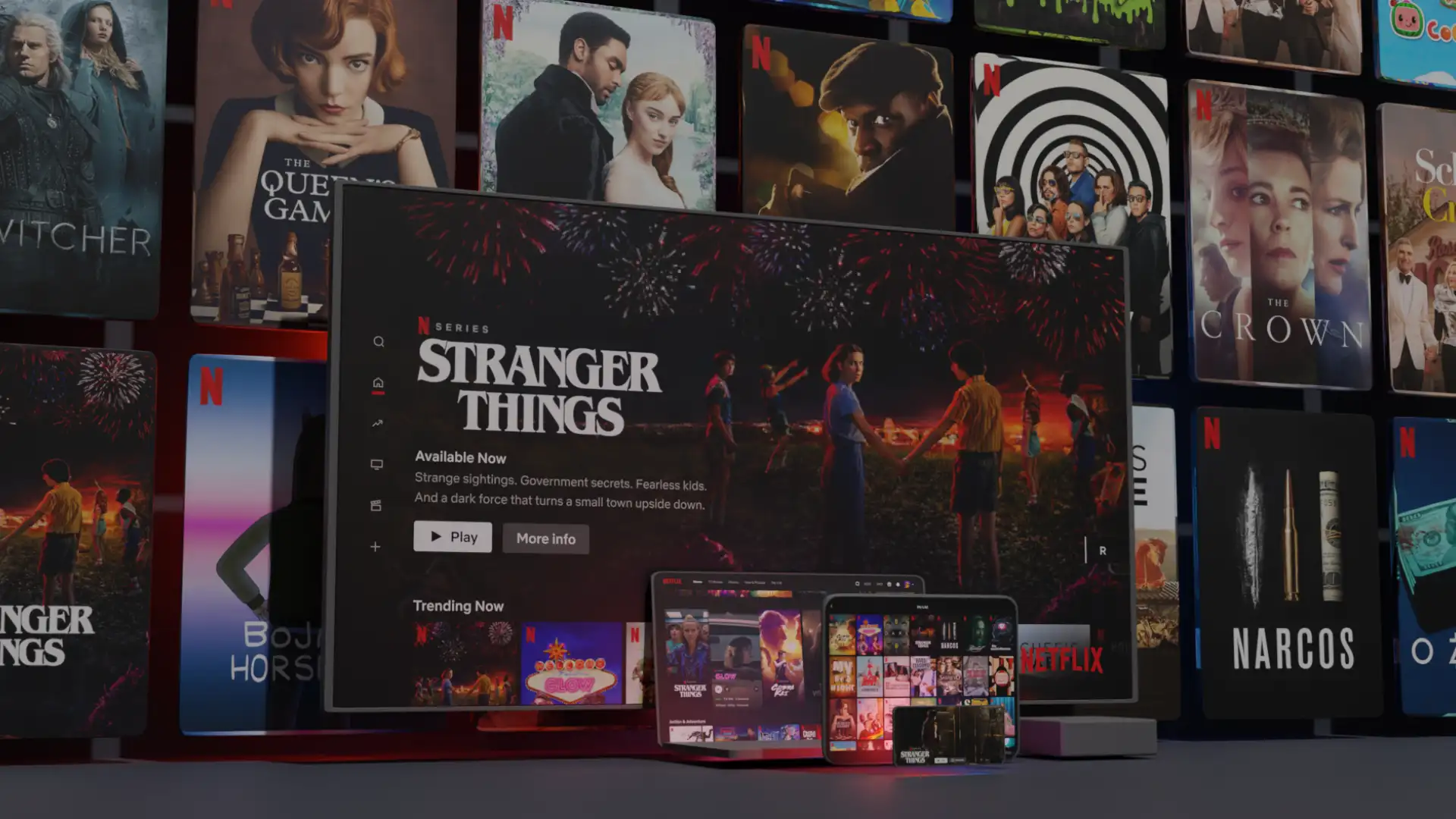
Customer Relationships
Continuous Content Updates
Netflix is renowned for continuously updating its content library to keep customers engaged. The volume of new content makes it feel like there’s always something new to watch. While quantity doesn’t always mean quality, the sheer number of originals allows Netflix to appeal to niches and experiment more.
Responsive Customer Support
They offer 24/7 assistance via live chat, phone, and self-help options on their website and app. Netflix utilizes data and AI to better understand problems and provide personalized solutions. For example, virtual assistants on their platform use natural language processing to get customers answers.
Regular Communication
Netflix communicates regularly with subscribers to inform them of new releases and features. For example, upon signing up, users choose preferences to receive personalized notifications highlighting content they may enjoy. Netflix also emails members regularly with top picks, reminders of titles about to leave the service, and announcements of originals.
Community Engagement
Netflix fosters community engagement by connecting fans around content. For example, the “Netflix Is A Joke” Instagram account has over 2.3 million followers and shares humor and memes for comedy fans. Netflix also hosts events like “Tudum” to announce new releases, bring together creators and talents, and allow subscribers to interact.
Churn Prevention
Metrics like streaming activity, profile engagement, and membership duration flag potential churn. Netflix then contacts these subscribers with incentives to stay, such as free service extensions or account upgrades. Other retention tactics include highlighting recommended titles based on viewing history and sending reminders about expiring favorites.
Key Resources
Content
Netflix’s massive investment in original shows and films is crucial for attracting and retaining subscribers in an increasingly competitive streaming market. Netflix aims to offer something for everyone; last year, they released over 600 original titles across languages and genres. Hits like Stranger Things, Bridgerton, and Squid Game show Netflix’s ability to create global franchises.
Technology Infrastructure
Netflix prides itself on using advanced cloud computing and data science to refine its streaming technology and personalization algorithms. Netflix’s platform must seamlessly deliver high-quality video while handling incredible traffic.
They work with AWS and other providers to optimize energy efficiency. Features like localized content libraries and Downloads For You use data to enhance the user experience. Big data also helps Netflix analyze viewing patterns and determine what content to produce.
Talent and Creativity
Netflix’s unique company culture and brand attract top creative talent across entertainment. Their lack of creative constraints enables risk-taking that can yield breakthrough hits. Showrunners like Ryan Murphy and Shonda Rhimes have been lured into multi-year production deals. Netflix also partners with or acquires existing production houses worldwide. Internally, continuous A/B testing allows data-driven creative decisions.
Customer Data
Netflix gains valuable insights from customer data to inform content and product decisions. Users receive personalized recommendations based on viewing history and machine learning algorithms. It analyzes overall viewing trends to predict demand and optimize content licensing or production. Subscription data determines price elasticity, which guides pricing models. Account sharing detection relies on behavior patterns and device tracking.
Brand and Reputation
As a pioneer in on-demand video, Netflix capitalizes on its reputation for disrupting old media to attract talent and subscribers. Its brand appeal stems from an emphasis on creative freedom, risk-taking, and leveraging data. Netflix’s brand also benefits from heavy marketing of its original hits and a unique culture that empowers employees. However, controversies around content and business decisions can also impact Netflix’s brand reputation.
Financial Capital
Netflix requires substantial financial capital to license and produce content, as well as build out its streaming infrastructure and technology. This continuous spending is necessary as Netflix operates in a highly competitive, hit-driven business with constant pressure to generate new hit shows. Their subscriber growth and recurring subscription revenue provide stability and allow them to raise large amounts of debt capital to invest aggressively in content.
Key Activities
Content Acquisition and Production
Content acquisition and production are core to Netflix’s success. They’re spending billions creating original shows and acquiring streaming rights to programs. In 2021 alone, Netflix released over 70 original films. From Stranger Things to Squid Game, these premium shows attract and retain subscribers.
Content Distribution
For distribution, Netflix utilizes the internet and apps to deliver content directly to customers. With such a huge subscriber base, their infrastructure has to scale massive streaming loads. They’ve built Open Connect, a content delivery network, to optimize video quality. Netflix even designs device software to improve streaming speeds.
Customer Relationship Management
Managing customer relationships starts with personalized recommendations. Powerful algorithms analyze your viewing history to suggest new shows you’ll love. This keeps you engaged and subscribed. Netflix also focuses on customer service; they aim to quickly resolve account issues to prevent churn. Surveys show their customer satisfaction is quite high.
Marketing and Promotion
Now for marketing, Netflix promotes new releases on TV, online, and billboards. But their best marketing is through word of mouth. Buzzworthy original shows like Black Mirror spread organically. This viral social media marketing is both cheap and effective. Netflix also emails subscribers with customized trailers and alerts—you’re marketed to, but it feels personalized.
International Expansion
Netflix operates nearly worldwide, tailoring content for local markets. They’ve invested in foreign-language shows and films. This has increased their market penetration. Even in new markets like India, Netflix is growing subscribers rapidly. Global streaming subscriptions were over 220 million in 2021—up from under 2 million in 2010.
Conclusion
Looking ahead, Netflix has tremendous opportunities to evolve their successful business model. With saturation increasing in existing markets, global expansion is key – focusing on localization, mobile-centric pricing, and content catered to international audiences can unlock major growth, especially in developing regions. The future remains full of potential for this category-defining platform.

I have always been fascinated by the inner workings of companies and industries. So I decided to study business to explore it more. My goal is to take all my research and turn it into cool stories that give people a better understanding of the business world.

